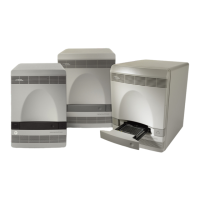Chapter 5 Generating Data from RQ Plates – 7500 Fast System
Before You Begin
38 Applied Biosystems 7300/7500/7500 Fast Real-Time PCR System Relative Quantification Getting Started Guide
Notes
FAST
FAST
Before You Begin
Check that background and pure-dye runs have been performed regularly to ensure
optimal performance of the 7500 Fast system. For more information about calibrating
the 7500 Fast system, refer to the Online Help.
Fast System
Requirements
• 7500 Fast System with fast hardware and software:
– Sequence Detection Systems Software v1.3 or higher
• Fast reagents and plastics:
– 7500 Fast System 96-Well Spectral Calibration Kit 1 (PN 4360788)
– 7500 Fast System 96-Well Spectral Calibration Kit 2 (PN 4362201)
– Optical 96-Well Fast Thermal Cycling Plate with Barcode (code 128)
(PN 4346906)
–TaqMan
®
RNase P Fast 96-Well Instrument Verification Plate (PN 4351979)
–TaqMan
®
Fast Universal PCR Master Mix (2✕), No AmpErase
®
UNG
(PN 4352042)
–TaqMan
®
Gene Expression Assays (PN 4331182)
IMPORTANT! A single RQ study cannot combine RQ plates run under different thermal
cycling conditions.
Preparing the PCR Master Mix
The second step (PCR) in the two-step RT-PCR procedure is amplifying the cDNA.
Perform this step using the TaqMan
®
Universal PCR Master Mix reagents.Users of the
7300/7500 system must use standard TaqMan Universal PCR Master Mix (2x) for an
approximately 2 hour run time. Users of the 7500 Fast System can choose either the
TaqMan Universal PCR Master Mix (2x) or TaqMan Fast Universal PCR Master Mix
(2x); use of the TaqMan Fast Universal PCR Master Mix (2x) allows for a run time of
fewer than 40 minutes. For further information on the use of Fast Master Mix, refer to
TaqMan Fast Universal PCR Master Mix Protocol (PN 4351891).
IMPORTANT! If you are using TaqMan Fast Universal PCR Master Mix, you must start
the run within 4 hours of preparing the plate.
CHEMICAL HAZARD. TaqMan
®
Fast Universal PCR Master
Mix (2✕) No AmpErase
®
UNG may cause eye and skin irritation. Exposure may cause
discomfort if swallowed or inhaled. Read the MSDS, and follow the handling
instructions. Wear appropriate protective eyewear, clothing, and gloves.

